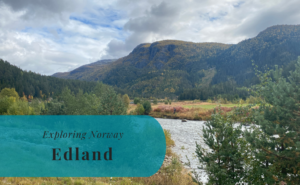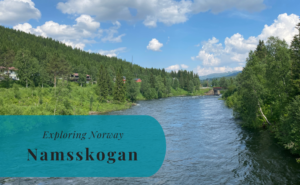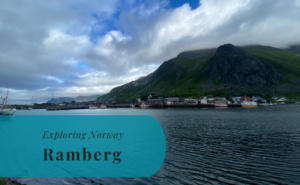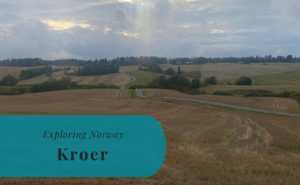Bodø is a coastal town in northern Norway and for many the gateway to the Lofoten archipelago. The town is in the traditional district of Salten in what is today Nordland County. This is an area just north of the Arctic Circle. Bodø is with its 40.000 inhabitants the largest town in Nordland County and the second-largest town in northern Norway. The town is on a peninsula along the eastern shores of Vestfjorden, a large fjord or sea between the Salten district and the Lofoten archipelago.
Interesting fact: Bodø is a part of Sápmi, the cultural region in northern Norway, Sweden, Finland, and Russia that is inhabited by the Sámi people. The name of the town in Lule Sami, which is the language spoken by the local Sámi, is Bådåddjo.









A Short History of Bodø
This area has been inhabited for centuries prior to becoming a part of what is today Norway. Fishing and boat building have played an important part in the livelihood here. The area belonged during the Viking Age to the kingdom of Hålogaland. Bodø continued to play a central role in the region of Nordnorge, but it took until the 19th century before any major development took place. Bodø became a town in 1816 when the local factory Hundholmen was granted township status. The earlier small village has since expanded both in regards to land and population.
A Diplomatic Dispute
The new town became known already in 1818 when it was the center of the Bodø Affair. This was a diplomatic dispute between Sweden-Norway and the United Kingdom. The establishment of trade in the town also brought with it illegal trading activities. A British trader John Everth came in 1818 with three ships loaded with contraband that the local authorities tried to seize. It resulted in a dispute that lasted until 1821, involving kidnappings, escapes, counterfeit documents, and many influential men in Britain and ministers in Sweden and Norway. British influence did eventually prove to be the most significant factor in the final outcome resulting in payments to the British.
Fishing, War, and Further Development
The population of the town remained low for the first decades. In 185, there were still just 230 inhabitants. That changed in 1864 with the arrival of a long period of large herring schools. The herring stayed until the 1880s and the town had at the turn of the century around 6000 inhabitants.
The Second World War meant severe destruction of large parts of the town. It was one of the most severely bombed towns in Norway during the war and large parts of the population lost their homes. It took seven years after the German retreat before the town was in most parts rebuilt. The last major building to be restored was the courthouse which was completed in 1959. The following Cold War meant further military establishment in the area. It was especially the military airfield that became an important strategic resource for NATO.
Bodø has since the end of World War II continued to grow. The population exploded during the 1950s and had in 1965 grown from around 5.400 inhabitants at the end of the war to around 14.000. New communications also connected the town with the rest of Norway. The ferries of Hurtigrutten were prior to the war the main means of transportation. It was joined by flying in 1950 and railway in 1961.








Things to Do and See
The gateway to Lofoten has a lot to offer by itself. The cold Atlantic water is never far away, the mountains are visible in the background and the modern town rises at the shores of the peninsula. Many sights are related to the Second World War or its aftermath, but there is a bit more to explore.
Bodø Cathedral
Bodø Cathedral, or domkirke in Norwegian, is close to the center of the town. The first church in Bodø was built in 1887, but it did not survive World War II as it was destroyed in bombings in 1940. The new church, the current cathedral, was completed in 1956 and has seats for about 850 people. It is a part of the Church of Norway.
Bodø City Museum
The Bodø City Museum is housed in one of the oldest surviving buildings in the town. The yellow building is dating back to 1903 and exhibits important objects from the area’s past.
Norwegian Aviation Museum
The Norwegian Aviation Museum, or Norges nasjonale museum for luftfart as it is known in Norwegian, is where you can learn more about the aviation history of Norway. The museum has several known aircraft models, both military and civilian. Here you can find the Starfighter, the Catalina, the Spitfire, and many more.
Bodø Bunker Museum
The Germans built several bunkers in Bodø during the Second World War. One of these bunkers, the one at Jentofthaugen, has been turned into a museum by a local group known as Bodø Bunkermuseum. The bunker was built in the winter of 1943 and 1944. It was used as a transmitting station for the German Luftwaffe. The renovations took place in 2014 and the museum is today open on request.
Norwegian Jekt Trade Museum
Norwegian Jekt Trade Museum showcases an important part of Norway’s history. The trade of stockfish was important for the area and was usually carried out on jekts. A jekt is a kind of cargo sailboat that delivered these stockfish from all the way to Bergen. The museum’s exhibit is centered around the one only jekt that remains in northern Norway, the Anna Karoline. This is the one and only out of what is believed to have been more than 3000 of these ships.








How to Get to Bodø
- Flights: Bodø Airport (BOO) is directly on the outskirts of the town. It offers mostly domestic flights to towns such as Oslo, Tromsø, and Trondheim. But there are also seasonal international flights available.
- Car: The town is located where road 80 meets the sea in the west and continues with the ferry to Moskenes in Lofoten. In the east, this road continues to the town of Fauske, where it connects to the E6 going through Norway between Oslo and Kirkenes.
- Train: The railway connects Bodø with Trondheim as an end station along the Nordland Line.
The driving distance from 5 major Norwegian cities, according to Google Maps:
- Oslo – 1195 kilometers (15 h 58 min)
- Bergen – 1332 kilometers (19 h 12 min)
- Trondheim – 703 kilometers (9 h 42 min)
- Narvik – 301 kilometers (5 h 1 min)
- Kirkenes – 1214 kilometers (14 h 51 min)
Find out more about other destinations in Norway by visiting our page Exploring Norway






